As well as finding the inevitable cartridge cases, we will also come across the odd part of a Mills hand grenade, sometimes without even realising. So, I have gone through all of my Mills grenade parts that I have collected over the last 13 years, and put together every individual manufacturers markings of the Mills that I have found.
The Mills grenade was invented by William Mills in April 1915, with the first version being the No.5. Late WW1 versions were the No.23 and No.36, which included a threaded hole in the base to convert the hand grenade to a rifle grenade. More of that later. The No.36 (and latterly the No.36M, ‘M’ standing for ‘Mesopotamia’, indicating that the grenade has been waterproofed), continued to be used in the Second World war and right up to 1972, when it was replaced by the L2 grenade.
I have put together a list of most of the known Mills grenade makers, and made the list as a downloadable PDF, which will be useful reference material for the collector.
These are my own two deactivated Mills grenades – A No.5 made by Mills Munitions Co., Birmingham in November 1916 (left), and a No.36M made by Revo Electric Co, Tipton, Staffs in 1940 (right).


The Mills No.36M disassembled, with the exception of the internal guide tube, or ‘centre piece’ as indicated in the below diagram.
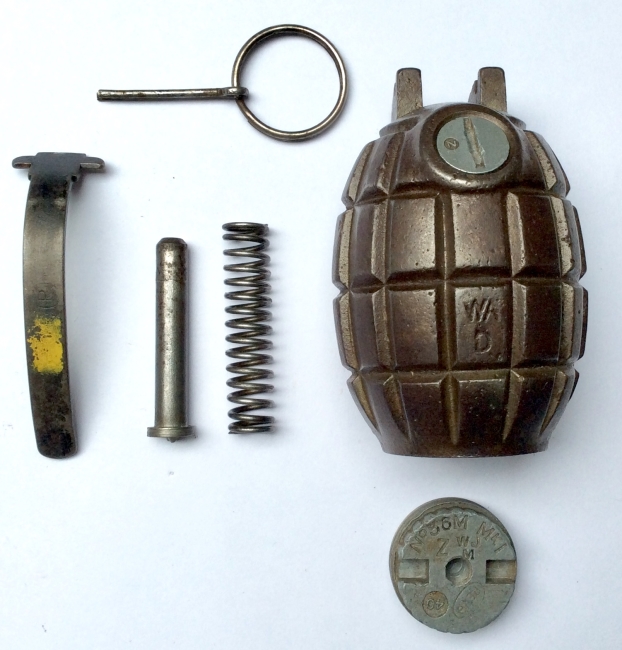
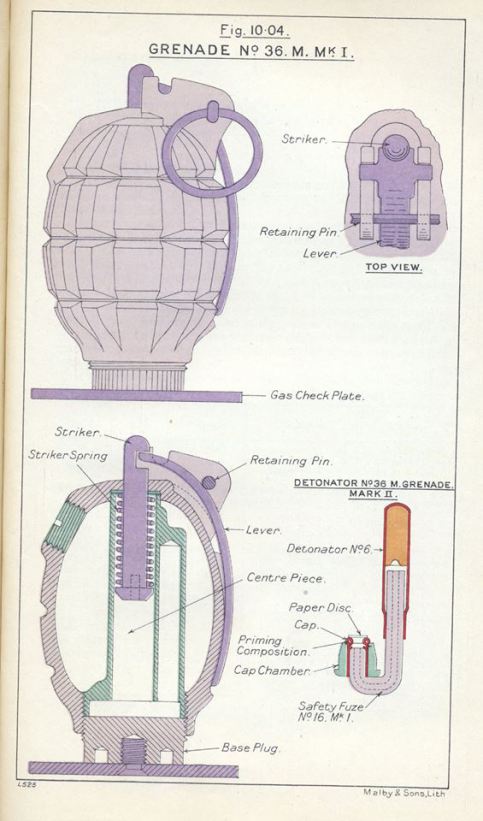
When we compare the ‘mint’ parts of my grenade, the placement of the mangled bits become clear. What is found in bountiful amounts are bits of the inner guide tube, which holds the firing mechanism and detonator. The base of the guide tube in my grenade can be seen in the second pic (where the detonator would be placed).
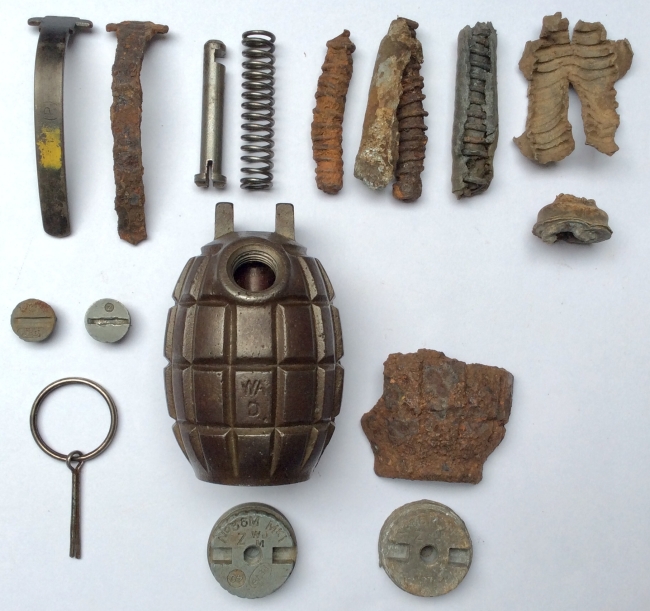
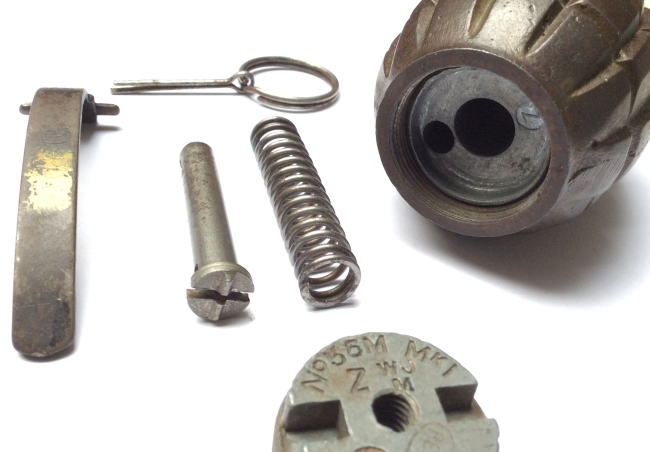
On to identifying the finds. Amazingly, I found a near enough whole guide tube, that didn’t get ripped to shreads on detonation (it seems only the detonator went off). Even these have makers marks, and this one is W – John Wilkins & Co., London and dated 1945.

Base Plugs.
Base plugs are the large caps on the base of the grenade, and has information stamped onto it with the makers name, type and year. They are often found, and there are over 200 different variations making them somewhat collectable in their own right!
Here’s how to read the information on the base plug.

Most base plugs have two makers codes, one maker who made the part itself and another makers mark of who assembled the grenade, along with a year and if made of Zinc, a letter ‘Z’ is present.
There are many different makers, this list is just the ones that I have found. Bear in mind that these base plugs were found in acidic Devon soil and some are a bit hard to read.

AF – It isn’t clear who this is, but it’s likely A. Fenwicks, Birmingham. This plug is also made of brass and not the usual Zinc. Only 5% of Mills grenades made in WW2 have brass base plugs.

AM – A. Marston & Co., Wolverhampton. WDC is the foundry maker – Wolverhampton Diecasting Co.

Crescent – Patent Die Casting, Willesden Green, London.

PDC – Patent Die Casting, Willesden Green, London, with the earlier initials. (Found on Woodbury Common by Phil Hawkins).
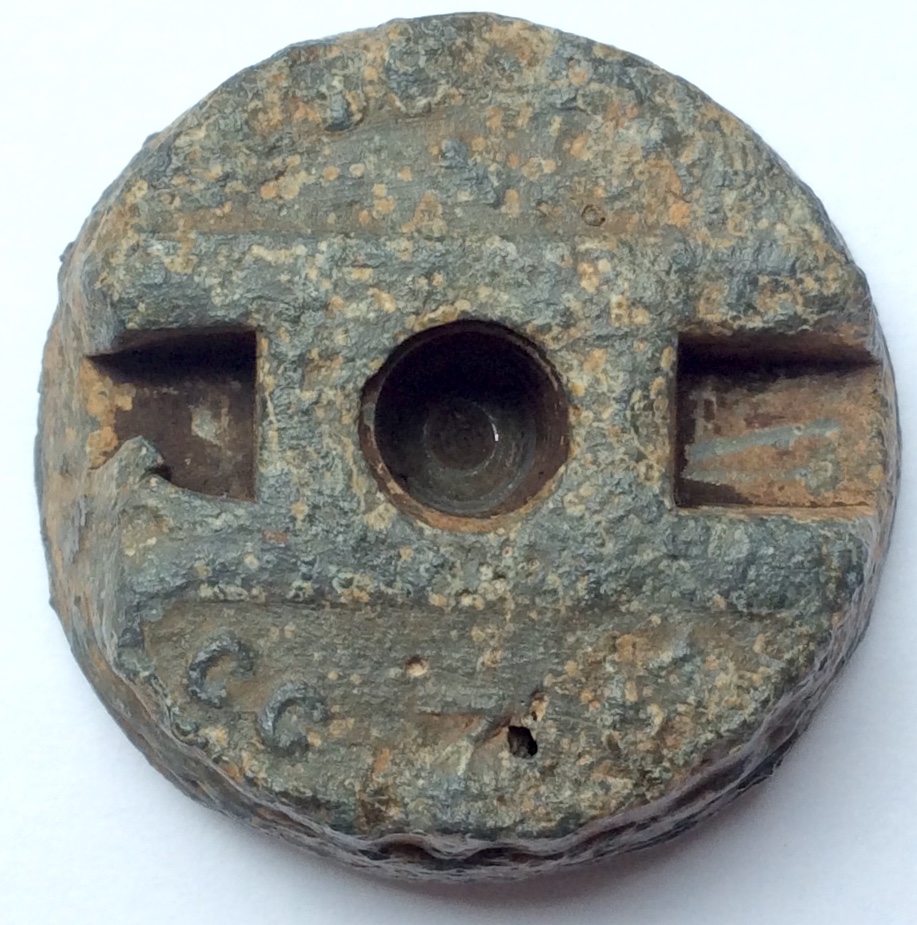
CC – Carron Company, Falkirk, Scotland.
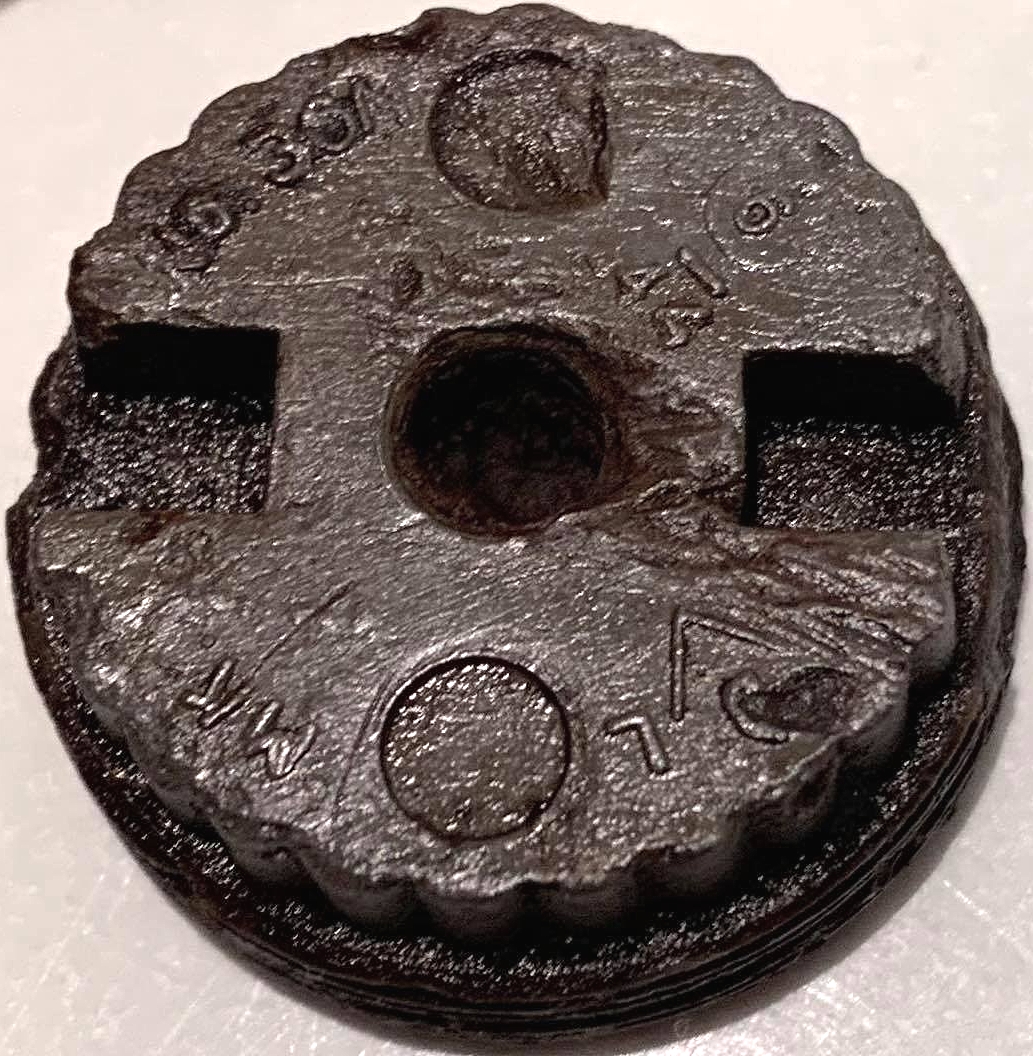
D (inside diamond) L – As yet unknown. (Found on Woodbury Common by Phil Hawkins).

E.E.Co – English Electric Co., Kingsway, London.

FB – Fallows & Bates, Manchester. (Found on Woodbury Common by Phil Hawkins).

G&ML – Glover & Main Ltd, Edmunton, London.
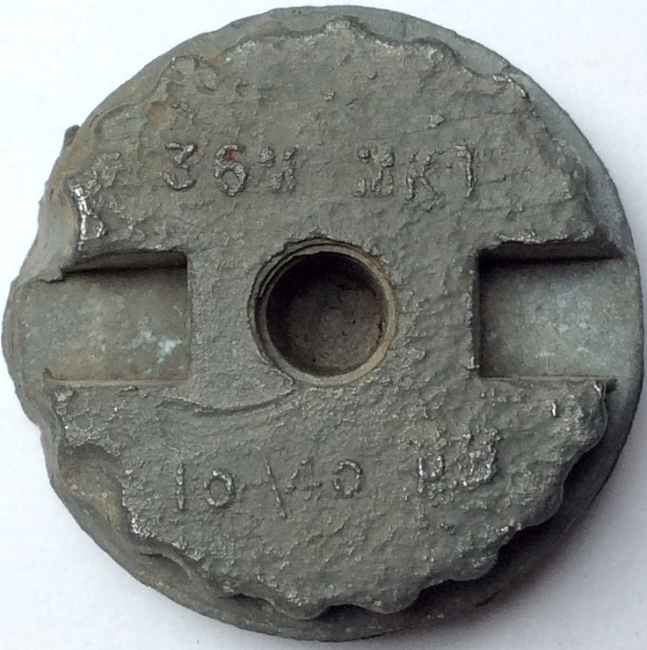
HD or HB, can’t tell with the condition. Possibly HB – Howard & Bullough Ltd, Accrington.

HLD – As yet unknown.

JH – John Harper, Willenhall, Staffs. The JHT monogram next to it is the foundry maker – J. H. Tucker & Co., Hay Mills, Birmingham.
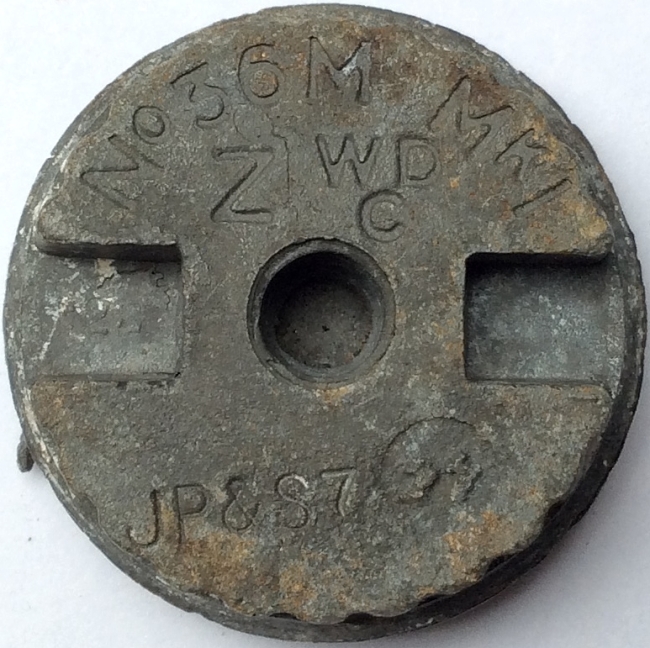
JP&S – Josiah Parkes & Sons, Willenhall, Staffs. WDC is the foundry maker – Wolverhampton Diecasting Co. WDC was a prolific maker of Mills parts.

Another JP&S – Josiah Parkes & Sons, Willenhall, Staffs, with the foundry maker – ORB, as yet unknown.

K with stars – A. Kenrick & Sons, West Bromwich. SF is the foundry maker – as yet unknown.

K – Kynoch & Co. Witton, Birmingham. APDP is the foundry maker – Alloy Pressure Die Products Ltd.

LC&Co – As yet unknown. APDP is the foundry maker – Alloy Pressure Die Products Ltd.

PSC – Parkinson Stove Co., Stetchford, Birmingham.

REVO – Revo Electric Co, Tipton, Staffs.

ROF (P) – Royal Ordnance Factory Patricroft, Patricroft, Eccles, Greater Manchester.

S inside diamond losinge – Schultz Diecasting Co., Wallaceburg, Ontario, Canada. The marking for this one is very hard to see, it’s the microscopic ‘S’ to the right of the ’44’.

‘S‘ – Joseph Stokes Rubber Co., Ontario, Canada. (Found on Woodbury Common by Phil Hawkins).
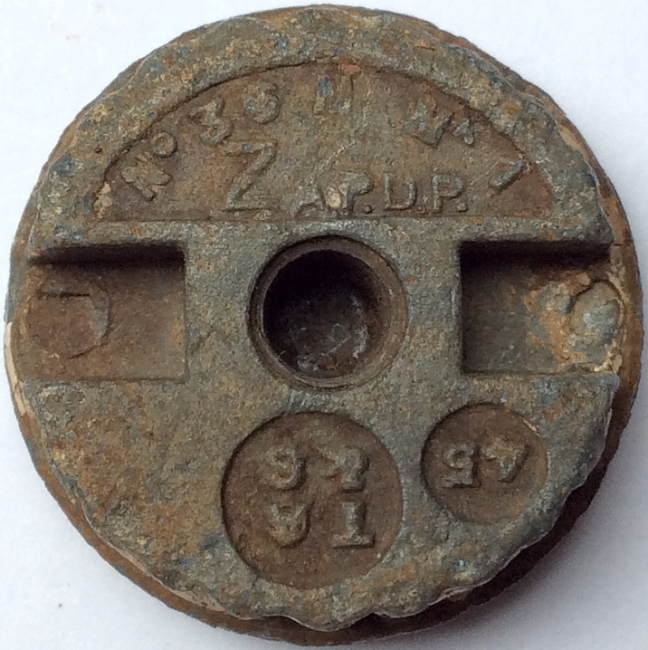
TA&S – T. Ashead & Sons, Dudley, Wocestershire. APDP is the foundry maker – Alloy Pressure Die Products Ltd.

TG&Co. – Thomas Glover & Co., Edmunton, London. Again, APDP is the foundry maker – Alloy Pressure Die Products Ltd.
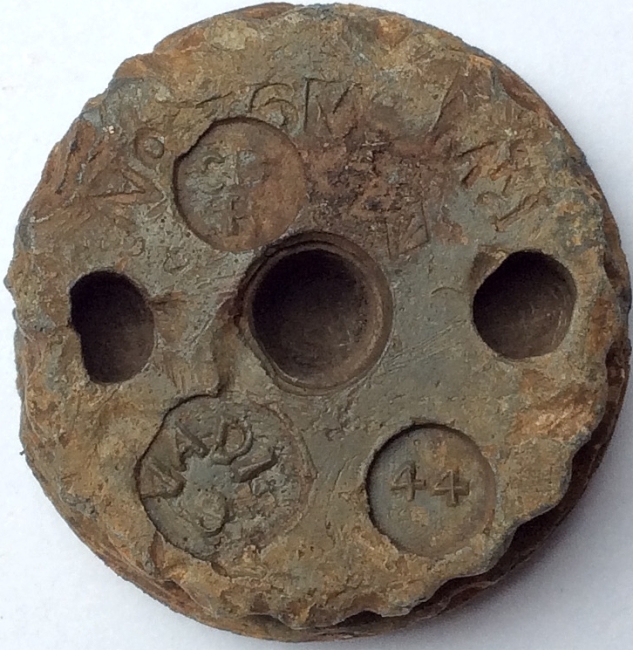
VADIS – Davis & Brocklesbury, Manchester. SDR is the foundry maker – Strebor Die-Casting Co Ltd, Manchester.

Another VADIS – Davis & Brocklesbury, Manchester, with the earlier name inside an oval. WDC is the foundry maker – Wolverhampton Diecasting Co.

Another VADIS – Davis & Brocklesbury, Manchester. The RE&S emblem is the foundry maker, as yet unknown. (Found on Woodbury Common by Phil Hawkins).

Walsall Ltd. (Found on Woodbury Common by Phil Hawkins).

WML – Wilson & Mathiesons Ltd, Leeds. This maker was very small indeed. This plug dates to 1940, and in that year, Wilson & Mathiesons only made 60,000 grenades, which sounds a lot, but the other larger factories made them in the hundreds of thousands or into the million each year. If you see a WML 1941, keep it! Wilson & Mathiesons only made 16,000 in 1941.
Filler Screws.
The filler screw is on the upper side of the grenade. Once assembled, the empty grenades would be sent to a ‘filling factory’, where it would be filled with Baratol explosive via the hole. These screws are only to serve as a plug to cap the hole.
This is the filler screw removed from my Mills.

The filler screws have makers names, too. Most of these I haven’t yet been able to identify, except for the WDC, Wolverhampton Diecasting Co and APDP, Alloy Pressure Die Products Ltd.

Gas Checks.
I mentioned at the top of the page about the threaded hole in the base of each base plug on the Mills No.36. The threaded hole is for the attachment of a metal disk known as a ‘Gas Check’. The gas check allows the grenade to be fired from a Lee Enfield rifle. On the rifle, a metal tube is fixed onto the muzzle and the grenade with gas check is slid into it. The rifle is loaded with a special blank cartridge, and the gas check acts like a piston, ensuring adequate propulsion of the grenade.
This is a gas check that I found. Due to the deterioration, it will no longer screw onto the base plugs, of course.


These are two diagrams showing how the rifle grenade aspect of the Mills is used.


Hi, my mate has a Great War No. 5 Mk I Mills with presumably the maker’s initials, “C.A.V” in an oval ring. Any idea who that might be? I’m working on the next newsletter for our Otago Branch of the NZ Antique Arms Association, “Hangfire” – I’m the editor. I can send it to you if interested. Thanks, Keith.
LikeLike
Hi Keith, sounds interesting! ‘CAV’ in an oval would certainly be the makers initials – C.A. Vandervell & Co. (Charles Anthony Vandervell), Warple Way, Acton Vale, London, UK. C.A. Vandervell & Co. also made radios, as well as Mills grenades! I would certainly be interested in seeing it. Many thanks, Best regards, Simon
LikeLike
[…] One of the more fascinating and better preserved objects were the filling plugs (pictured below). We found a half dozen of these and they were mostly in good shape with threads intact. The distinctive plug is what makes me think that these were British issue “Mills” No. 36 MK 1 hand grenades. […]
LikeLike
I found a load of these and shrapnel Detecting near Bromsgrove, my question why were they throwing live grenades for practice?
LikeLike
Hi hey do u know of a maker with the initials ESH&S ? It’s a no.36 M1
With an 11 above the centre hole and 18 beneath. do you have any ideas on the markings I can’t seem to find anything
LikeLike
ESH&S – E.S. Hindley & Sons, Bourton, Dorset. The 11 and 18 would be the date – November 1918. Near the top of the page is a downloadable PDF list of makers, that I made which might be useful for future reference. 🙂
LikeLike
Found a filler cap with b1 in a square as a war department logo on other side . The cap is slotted and two -holes in it like a devide sign .. any ideas of maker ..
LikeLike
I am closing my gun shop and found in my psoession a Mills grenade maked with the No 2 under where the lever would fit, on the oposite side there appears to be either s/s could even be 5/S was never finsihed as a complete Grenade so is empty and has never been machined for the pin or filling cap.
Simply, has it any value to a collector or otherwise. Tia.
LikeLike
Nice find! It certainly would have some collectors interest indeed! Especially being an unfinished casting, those are quite uncommon to find on the collectors market. 🙂
LikeLike
Hi, have 2 no 36 mills bombs, dated 1943 and 1944 (Inert no powder) 2 outer casings, no drilled or tapped and trying to find a value.
LikeLike
Hi Simon, great resource, have a base plug with TG & S-thought Thomas Glover but what’s the ‘S’ instead of a ‘C’ mean?
LikeLike